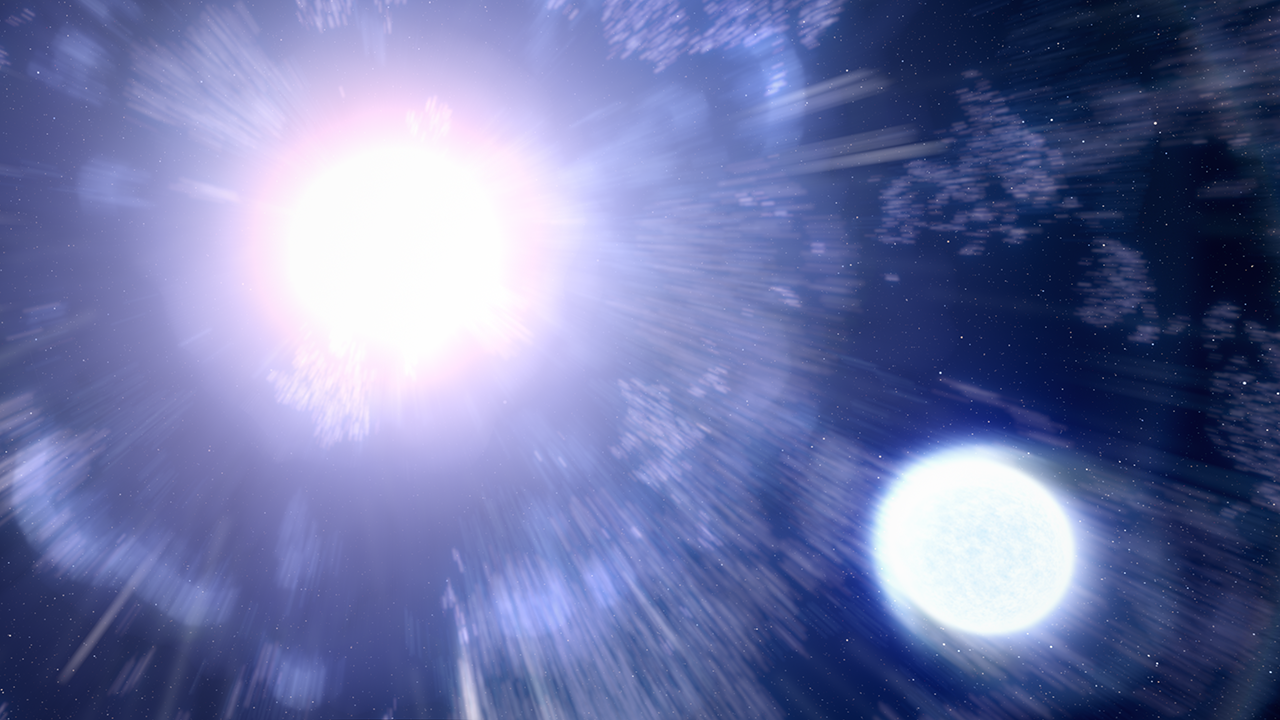Supernova 'wreckage' blasts out cosmic rays in deep space
Astronomers tracked cosmic rays to objects that launch particles with energy 10 times greater than the Large Hadron Collider.

Some space radiation crashing into Earth has an explosive origin.
Astronomers spotted wreckage from a supernova explosion potentially capable of blasting out high-energy particles — or cosmic rays — that frequently bombard Earth.
Their new findings link shockwaves and wreckage created by dying stars to natural high-energy proton accelerators in space, which are dubbed PeVatrons. These intriguing cosmic accelerators — which receive their name from their ability to boost the energies of particles to extreme peta-electronvolt (PeV) levels — have never been conclusively identified.
A handful of suspected PeVatrons were already fingerprinted before this study, including one at the center of our Milky Way galaxy. The research team says their new find of a supernova explosion's leftovers — a cloud of material called G106.3+2.7 — could be the most promising candidate yet.
Related: What is a supernova?
The wreckage lurks 2,600 light-years from Earth, possesses a comet-shape and has a bright pulsar — a highly magnetic rotating neutron star — at one end.
Because neutron stars form when stars undergo gravitational collapse, which also launches out supernovas, there is good reason for researchers to think that the pulsar and the supernova wreckage cloud were created by the same violent event.
Get the Space.com Newsletter
Breaking space news, the latest updates on rocket launches, skywatching events and more!
Using NASA's Fermi Large Area Telescope, astronomers spotted a high-energy gamma-ray afterglow that implies G106.3+2.7 may be capable of the PeVatron-associated feat of blasting out particles at energies equivalent to a million billion electronvolts — 10 times as great as energies generated by the Large Hadron Collider, Earth's most powerful particle accelerator.
"Theorists think the highest-energy cosmic ray protons in the Milky Way reach a million billion electron volts or PeV energies," assistant professor of physics at the University of Wisconsin, Madison, Ke Fang said in a NASA statement. "The precise nature of their sources, which we call PeVatrons, has been difficult to pin down."
Scientists suspect the supernova wreckage from dead stars accelerates particles to such high energies when charged particles are ensnared by magnetic fields around them. This process allows shockwaves from the supernova to buffet the trapped particles repeatedly, increasing their energy each time. Finally, the particles are so energetic that the supernova remains cannot hold on to them, and the particles escape into space at near-light-speeds as cosmic rays.
Tracing cosmic rays back to supernova wreckage has been difficult because the protons that comprise cosmic rays are electrically charged. Cosmic rays are thus prone to scattering while interacting with magnetic fields as they journey through space. Astronomers, therefore, cannot easily tell from which direction the rays are coming when they finally reach our planet.
Because the acceleration of protons to such high speeds causes the emission of gamma-rays, however, this high-energy light could be a good proxy for detecting the source of cosmic rays.
Related: Most Powerful Cosmic Rays Come from Galaxies Far, Far Away
Both Fermi and the Very Energetic Radiation Imaging Telescope Array System (VERITAS) at the Fred Lawrence Whipple Observatory, southern Arizona, detected gamma-rays from inside the tail of the supernova wreckage of G106.3+2.7. Additionally, other observatories have found extremely high-energy photons coming from the same area, indicating this could indeed be a PeVatron.
"This object has been a source of considerable interest for a while now, but to crown it as a PeVatron, we had to prove it is accelerating protons," researcher Henrike Fleischhack of NASA's Goddard Space Flight Center in Greenbelt, Maryland, said.
"The catch is that electrons accelerated to a few hundred TeV can produce the same emission. Now, with the help of 12 years of Fermi data, we think we’ve made the case that G106.3+2.7 is indeed a PeVatron."
To analyze gamma-rays from the comet-shaped cloud, the team had to first account for the pulsar — dubbed J2229+6114 — emitting its own gamma-rays as it rapidly rotates. Because the high-energy light is only blasted towards Earth during half of the pulsar’s rotational period, the researchers simply ignored gamma-ray emissions during this period.
The tail of G106.3+2.7 appears to emit few gamma-ray photons with energies below 10 Giga-electronvolts (GeV); above this benchmark, the pulsar’s effect was tiny. The lack of gamma-rays below 10 GeV also indicated the detected emissions were not caused by the accelerating electrons.
This finding led the researchers to infer that the source of some gamma-rays from G106.3+2.7 was indeed the acceleration of protons to PeV-level energies.
"So far, G106.3+2.7 is unique, but it may turn out to be the brightest member of a new population of supernova remnants that emit gamma rays reaching TeV energies," Fang said. "More of them may be revealed through future observations by Fermi and very-high-energy gamma-ray observatories."
The team’s findings are discussed in a paper published in the August 10 edition of the journal Physical Review Letters.
Follow us on Twitter @Spacedotcom or on Facebook.
Join our Space Forums to keep talking space on the latest missions, night sky and more! And if you have a news tip, correction or comment, let us know at: community@space.com.

Robert Lea is a science journalist in the U.K. whose articles have been published in Physics World, New Scientist, Astronomy Magazine, All About Space, Newsweek and ZME Science. He also writes about science communication for Elsevier and the European Journal of Physics. Rob holds a bachelor of science degree in physics and astronomy from the U.K.’s Open University. Follow him on Twitter @sciencef1rst.









